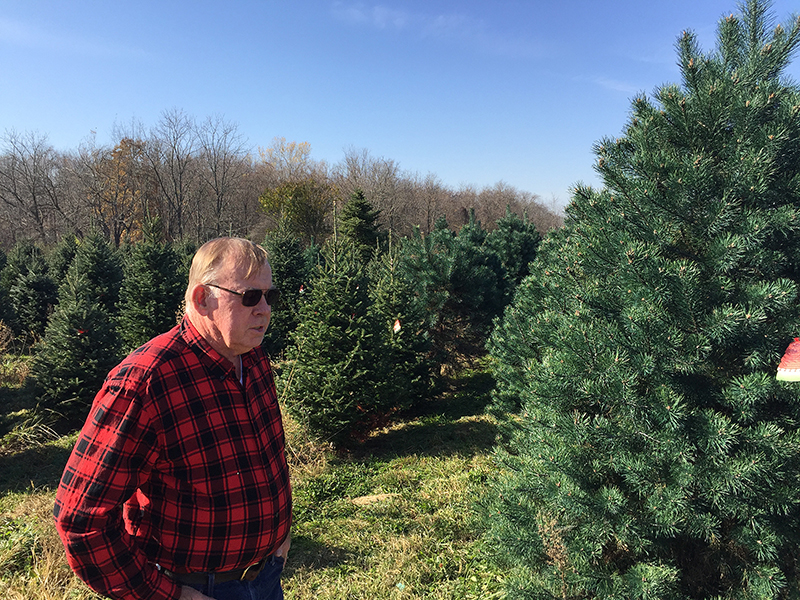November 28, 2016
Christmas tree supply looks strong for 2016 holiday season

Dan Cassens, Purdue University professor of forestry and natural resources and Extension wood products specialist, has grown Christmas trees for nearly 40 years on his farm, Cassens Trees. (Purdue Agricultural Communication photo/Darrin Pack)
WEST LAFAYETTE, Ind. - People ready for some holiday cheer can celebrate a healthy 2016 Christmas tree supply with plenty of choices in size and species, said Daniel Cassens, a Purdue University professor of forestry and natural resources and Purdue Extension wood products specialist.
A dry summer and wet autumn initially caused some worries, said Cassens, who has grown and sold Christmas trees for 38 years at his farm at 5038 Morehouse Road, West Lafayette.
"Conifers don't like wet feet and we had a wet August," he said. “And the dry June and July were a bit scary, especially for seedlings. But we've seen no lasting effects from weather and no significant insect or fungal problems either. The trees look very healthy."
Cassens, a member of the National Christmas Tree Association and the Indiana Christmas Tree Growers Association, said that while most tree shopping typically happens after Thanksgiving, some consumers had already started purchasing their trees by mid-November. Prices for Christmas trees typically vary according to the species, quality and size of the tree, with smaller trees selling for less than larger or more exotic ones.
"Scotch pine and eastern white pine are typically the least expensive trees in Indiana. Small ones less than 6 feet tall could cost as little as $15, while $25 to $35 should cover a premium 7- to 8-foot tree," Cassens said. "Douglas fir and spruce would be intermediate in both cost and care, while a Fraser or Canaan fir could sell for twice as much as a Scotch pine. And a tree taller than 8 or 10 feet will also be more expensive because of the additional time and care required for a taller tree."
Each variety of tree features a unique combination of branch stiffness, color and needle length. The popular Fraser fir has distinctive silvery undersides on its short needles and stiff branches that can hold heavier ornaments and decorations, while white pine trees have flexible branches and long, soft needles that may be safer for babies and small children.
Canaan fir is similar in appearance to Fraser fir and more commonly grown in Indiana. Available species may vary from farm to farm across the state, but most Indiana farms will have three or four varieties for sale, Cassens said.
When looking for the perfect tree, some considerations apply across species. It is important to measure the space where the tree will stand before coming to the tree farm - trees will look smaller out in the open field than they will in a house or apartment.
Choosing the correct type of stand will help the tree stay stable as it is decorated. A stand with a center spike that is inserted into the tree trunk provides a stable base and is easy to set up, Cassens said. Regardless of type, every stand should be heavy enough to keep the tree upright and should have a basin large enough to hold sufficient water. Many tree farms sell stands on the property.
"Christmas trees may not take up much water for the first couple of days, but don't let that fool you into thinking they won't," Cassens said. "Once the tree settles in and starts taking up water again, they typically require at least one quart per inch of stem diameter every day. A 7-foot tree could easily use two quarts of water a day for the first week."
If a tree does not receive sufficient water once it is brought inside, the cut end will seal over with sap. A tree that has gone without water for more than six or eight hours after being cut should have an additional one-half inch cut off the end to allow it to take up water. Placing the tree near a warm air vent or using decorative lights that get too hot can also cause the tree to dry out faster, Cassens said.
A live tree may require more care than an artificial tree, but for many people, Cassens said, the experience of having a live tree outweighs the extra effort.
"Some people choose a live tree to remind them of childhood memories, and others to do their part to help 'green' the environment," Cassens said. "Either way, with a little thought and care, a real Christmas tree can bring lots of joy and good memories during the holiday season."
Buyers can find more information in Cassens' free publication, Tips for First-Time Buyers of Real Christmas Trees, available from Purdue's The Education Store at https://www.edustore.purdue.edu/.
Writer: Jessica Merzdorf, 765-494-7719, jmerzdor@purdue.edu
Source: Daniel Cassens, 765-494-3644, dcassens@purdue.edu
Agricultural Communications: (765) 494-8415;
Darrin Pack, dpack@purdue.edu
Agriculture News Page

